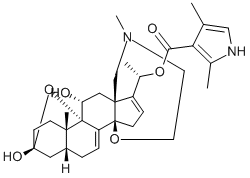Chemical Properties
Noncrystal.
Hazard
Extremely toxic; deadly poison; neurotoxic; cardiotoxic activity; bara-chotoxin that blocks neuromuscular transmission; respiratory paralysis; death.
Biological Activity
Potent neurotoxin that activates voltage-gated sodium channels. Shifts voltage-dependent activation to more negative potentials, inactivation is disabled and pore conductance and selectivity are altered (displays increased permeability for NH 4 + , K + and Cs + ions).
Safety Profile
A deadly poison byintraperitoneal, intravenous, and subcutaneous routes.When heated to decomposition it emits toxic fumes ofNOx.
Enzyme inhibitor
This lipid-soluble neurotoxin (FW = 526.67 g/mol; CAS 23509-16-2; LD50 = ~2 μg/kg mouse body weight.), isolated from the skin of the Columbian poison-dart frog Phyllobates aurotaenis, enhances Na+ conductance, promoting opening of voltage-gated Na+ channels, inducing depolarization of the resting membrane potential. It does so by binding to the sodium channel, keeping the membrane permeable to sodium ions in an all-or-none manner. This results in hyperexcitability of excitable tissues, followed by convulsions, paralysis, and death in animals. The most common use of batrachotoxin is in darts for bloguns used in hunting by the Noanamá Chocó and Emberá Chocó Indians of western Colombia. Batrachotoxin has also been identified in the feathers of the passerine birds of New Guinea Pitohui dichrous, Pitohui kirhocephalus, and Ifrita kowaldi. The less toxic batrachotoxin A is the deesterified steroid.
